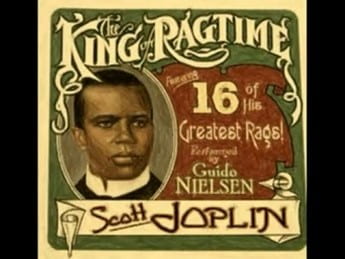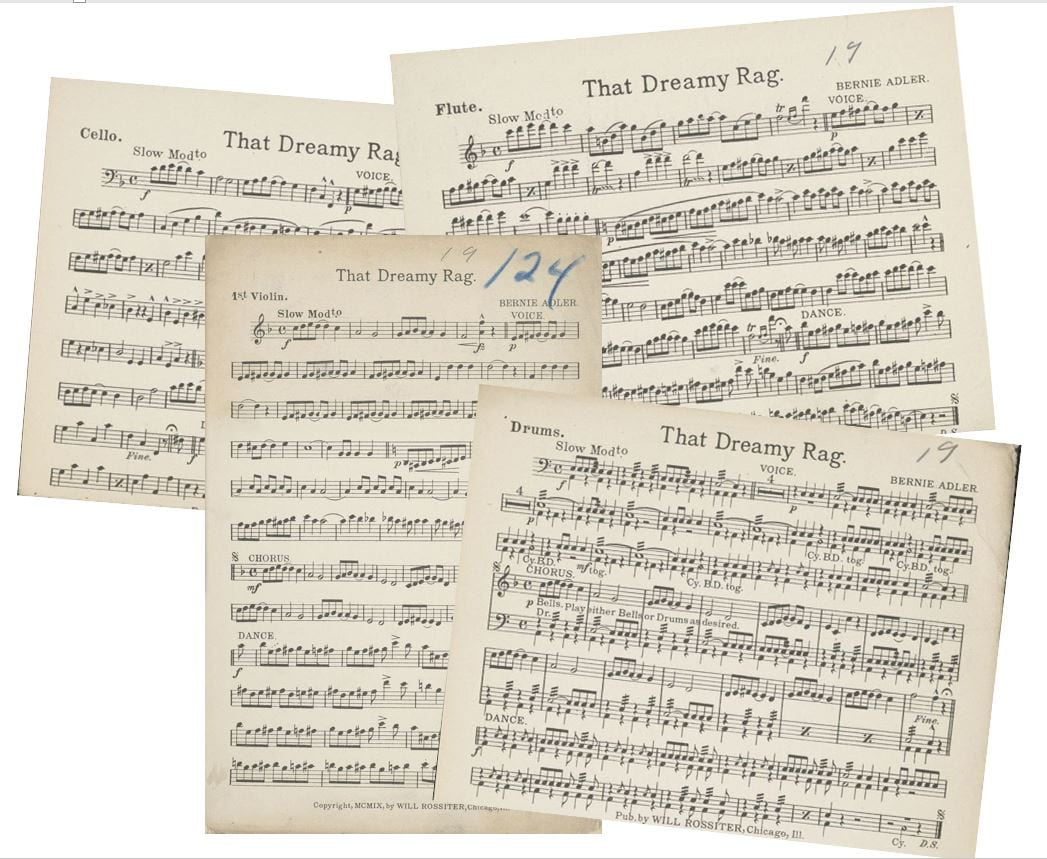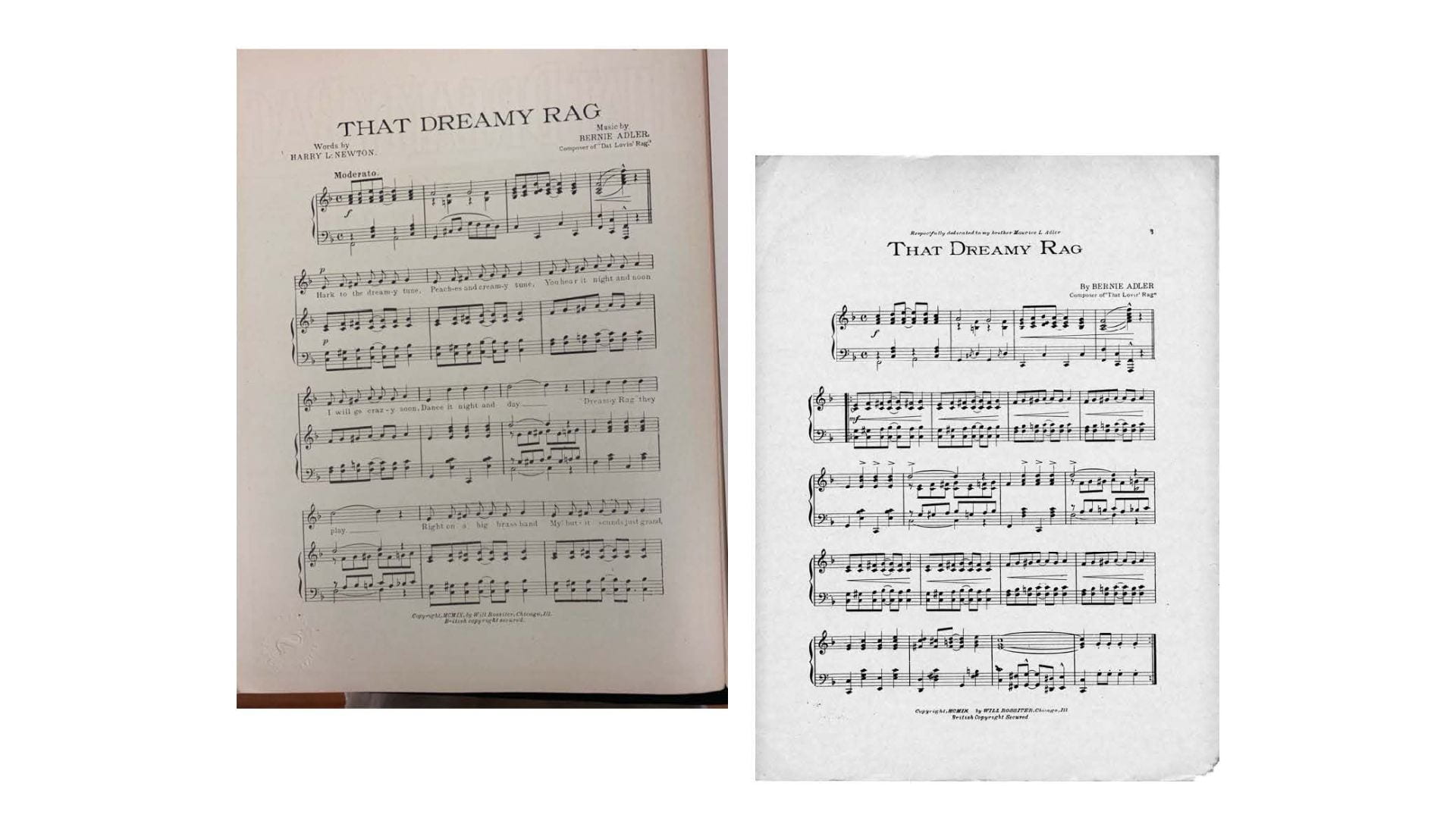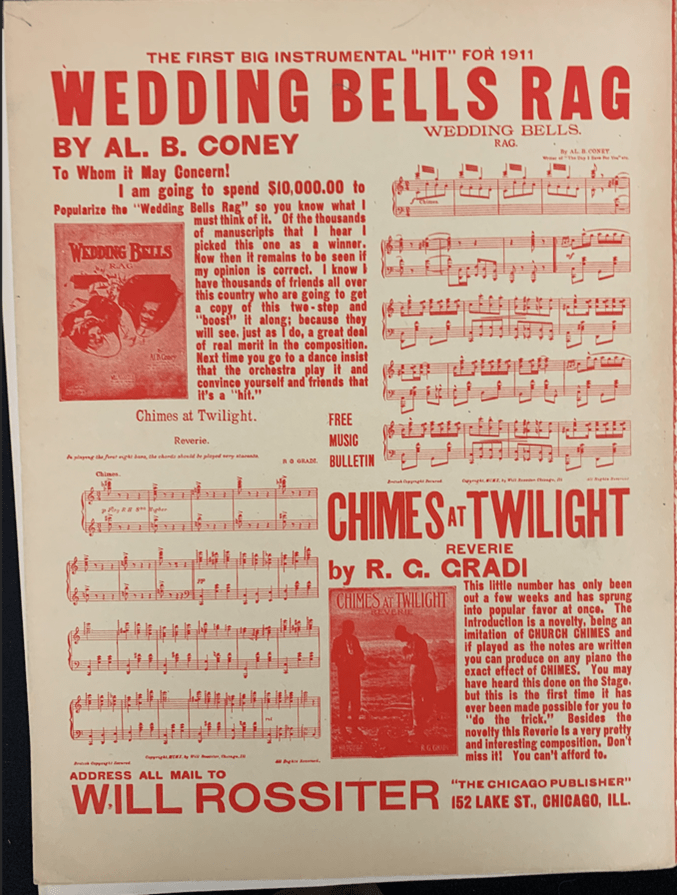What does music research look like? This is the third post in a series that highlights music research by students in a Baylor School of Music class taught by Dr. Laurel Zeiss, a recipient of the 2022 Special Collections Teaching Fellowship. These students worked beyond traditional research and learned how to engage with primary sources in the Baylor Libraries’ Frances G. Spencer Collection of American Sheet Music. Enjoy exploring this unique collection through our new scholars’ works.
That Dreamy Rag by Adler
by Revina Karani
History of Ragtime
 It was all the rage at the time. From the late 1890s to the early 1900s, ringing out of every parlor, through the windows, ringing in the streets, it was the music that got everyone out of their seats. Ragtime. Drawing from the marching band music of the same period popularized by John Philip Sousa, and minstrel shows, the syncopated rhythms and sectional forms of what would become known as ragtime grew in popularity as the 1800s drew to a close. This genre was popular not just for its distinct rhythms, but also for the culture it fostered as part of the vernacular music of the era. The most popular and well-known composer was Scott Joplin, who became dubbed the “King of Ragtime” because he developed the technique of syncopated rhythms and repeated sections in distinct phrases and repeated parts that create an identifiable and easy-to-dance-to rhythm. It is into this tradition that Bernard A’al Adler contributed to some of the period’s well-known “rags.”
It was all the rage at the time. From the late 1890s to the early 1900s, ringing out of every parlor, through the windows, ringing in the streets, it was the music that got everyone out of their seats. Ragtime. Drawing from the marching band music of the same period popularized by John Philip Sousa, and minstrel shows, the syncopated rhythms and sectional forms of what would become known as ragtime grew in popularity as the 1800s drew to a close. This genre was popular not just for its distinct rhythms, but also for the culture it fostered as part of the vernacular music of the era. The most popular and well-known composer was Scott Joplin, who became dubbed the “King of Ragtime” because he developed the technique of syncopated rhythms and repeated sections in distinct phrases and repeated parts that create an identifiable and easy-to-dance-to rhythm. It is into this tradition that Bernard A’al Adler contributed to some of the period’s well-known “rags.”
Background on Composer
 Bernard A’al Adler – commonly known as Bernie Adler – was born on May 8, 1879 in Chicago Illinois to a German immigrant father and California-born mother. He was the third of five kids. Details about his childhood are few, but it is assumed that he and his siblings received some sort of formal training in schools as Bernie and his brother Maurice both became involved in the music business in the older years.
Bernard A’al Adler – commonly known as Bernie Adler – was born on May 8, 1879 in Chicago Illinois to a German immigrant father and California-born mother. He was the third of five kids. Details about his childhood are few, but it is assumed that he and his siblings received some sort of formal training in schools as Bernie and his brother Maurice both became involved in the music business in the older years.
As Adler grew and after his first music publication in 1896, he worked with Arthur J. Lamb, a British immigrant. Lamb was the main librettist for a number of songs that embodied the caricaturist art culture of the time and reinforced prominent stereotypical images of African Americans. Most of these songs were referred to as part of the “coon” songs tradition, which perpetuated the image of black people as too lazy and cynical to change their situation and thus could only remain as slaves. Bernie provided the instrumental arrangements for many of these songs.
 After Lamb moved on, Adler didn’t publish very much until 1906 when he met small-town journalist, Victor H. Smalley. Both worked together to produce Adler’s most famous rag, “Dat Lovin Rag” which was dedicated to W.B. Dixon of St. Paul, Minnesota, Adler’s hometown. They later wrote a play together titled The Merry Widower with this rag as the highlight tune. After they both achieved this success writing rags and plays, they both got involved in the vaudeville theatre tradition, with Smalley managing a company and Adler joining a travelling vaudeville team.
After Lamb moved on, Adler didn’t publish very much until 1906 when he met small-town journalist, Victor H. Smalley. Both worked together to produce Adler’s most famous rag, “Dat Lovin Rag” which was dedicated to W.B. Dixon of St. Paul, Minnesota, Adler’s hometown. They later wrote a play together titled The Merry Widower with this rag as the highlight tune. After they both achieved this success writing rags and plays, they both got involved in the vaudeville theatre tradition, with Smalley managing a company and Adler joining a travelling vaudeville team.  Adler continued to write rags and in 1909, published “That Dreamy Rag” with lyrics by Harry L. Newton. Not much is information can be found about his life, but there are collections of his work as a lyricist and composer and some vaudeville works largely published between 1906 and 1910. He also seems to have been a part of compositions for minstrel shows.
Adler continued to write rags and in 1909, published “That Dreamy Rag” with lyrics by Harry L. Newton. Not much is information can be found about his life, but there are collections of his work as a lyricist and composer and some vaudeville works largely published between 1906 and 1910. He also seems to have been a part of compositions for minstrel shows.
How were these songs publicized?
As part of the growing emphasis on the role of the piano in the home, ragtime created a culture where the average person, particularly those part of the higher classes, were expected to be able to play the piano, especially the most well-known pieces of the time. As ragtime grew in popularity, it gained household fame and prominence. Adler’s most well-known piece “Dat Lovin’ Rag” became one of the more popular rags found in various homes. As Adler continued to explore the genre, “That Dreamy Rag” also gained prominence in the ragtime scene. Particularly as he and Smalley published various plays, they had a platform from which to promote their tunes. Oftentimes, the popular rags of the period were published in part in newspaper advertisements or named as some of the top songs to know. Some of these advertisements would offer to sell and deliver the printed works advertised.

What does the published work look like?
The published work from the Moody Memorial Library collection contains lyrics and music for piano. Other publications available online only contain instrumental arrangements for various instrumental parts in bands and orchestras as indicated on the front page.
Listen to a part of it here
The front page contains the title, the name of the composer of the words and music, the intended instrumentation, the publisher and a cover image. The title is preceded by the phrase “Some class to this, Babe.” The front image depicts four African American couples in a dance setting with a pianist in the background. They are all wearing fancy, ballroom type outfits with the women all wearing green bows and the men green lapel pins. The performance and publication details state that it is intended to be played by a band and orchestra. It was published in Chicago, Adler’s hometown, by “The Chicago Publisher,” Will Rossiter. Both the instrumental and “song” publications indicate the difference, with one containing the lyrics and the other only the instrumentalism, underneath the title.
There seem to also be some differences in the notation between the instrumental publication intended for piano and the work published with lyrics by Harry L. Newton. In the sheet music with lyrics, it begins with four eighth notes with the last eighth note tied to a quarter note that is then followed by another quarter note on the final beat of the bar. In the piano version, the music begins with a quarter note followed by two groupings of two eighth notes tied together and then a quarter note on the last beat as well. However, the second and fourth bars remain the same in notation. Another difference is the notation of repeats. In the piano version, there is a repeat bar beginning from the fifth bar to the last bar of the first page while the publication with lyrics doesn’t contain notation for repeats. It can be surmised that some of these differences were influenced by the partnership between Adler and Newton.
As was typical of the time, the printed work also contains advertisements of other artists on the back page. The publication with lyrics advertises an instrumental “Wedding Bells Rag” by Al. B. Cooney and “Chimes at Twilight” by R. G. Gradi. The instrumental arrangement publication contains different advertisements on the back page including a list of popular two-steps. Because this music had become so popular in the culture, the published pieces also served as a way of advertising other musical works because it could be assumed that a large number of people would have access.
Why is this tradition important?
Although the popularity of ragtime faded in the 1910s, it paved the way for a number of “American” music traditions today, such as jazz and the rhythm and blues movements that would follow in later years. Furthermore, ragtime elevated the role of the piano further and provided composers with the perspective of how to utilize the skills associated with this genre. It provided entertainment and was a novelty to many and attractive as a basis for many composers. Today, it still remains prominent in musical history for its unique contributions.
Works Consulted
- The Birmingham age-herald. [volume], Image 12, Aug. 22, 1909, p. 12, Library of Congress, https://chroniclingamerica.loc.gov/lccn/sn85038485/1909-08-22/ed-1/seq-12/#date1=1777&index=6&rows=20&words=Dreamy+Rag&searchType=basic&sequence=0&state=&date2=1963&proxtext=that+dreamy+rag&y=0&x=0&dateFilterType=yearRange&page=1. Accessed 25 Oct. 2022
- Cleveland Public Library Digital Gallery. Accessed 14 Nov. 2022.
- Edwards, Bill. “Bernard Aal Adler.” ragpiano.com/comps/badler.shtml
- Forney, Kristine, et al. The Enjoyment of Music. New York City, W. W. Norton & Company, July 2022.
- Pilgrim, David. “The Coon Caricature.” Ferris.edu, Ferris State University, Oct 2000, www.ferris.edu/HTMLS/news/jimcrow/coon/homepage.htm.
- Adler, Bernie. “That Dreamy Rag.” Words by Harry L. Newton. Will Rossiter, Chicago, III. Mar. 15 1909.
Images
- https://images.app.goo.gl/puqzC8qDyznrrMQPA
- https://www.simonandschuster.com/books/King-of-Ragtime/Stephen-Costanza/9781534410367
- https://www.google.com/url?sa=i&url=https%3A%2F%2Fen.wikipedia.org%2Fwiki%2FRagtime_%2528novel%2529&psig=AOvVaw2ZqUJ2APT4BNjQBpSlr_6l&ust=1669790316405000&source=images&cd=vfe&ved=0CA8QjRxqFwoTCNCP_evj0vsCFQAAAAAdAAAAABAD
- https://www.google.com/url?sa=i&url=https%3A%2F%2Fballadofamerica.org%2Fragtime%2F&psig=AOvVaw11VzK_X-vGmehEaGnypeXT&ust=1669790317386000&source=images&cd=vfe&ved=0CA8QjRxqFwoTCLizu_Dj0vsCFQAAAAAdAAAAABAD
- https://www.google.com/url?sa=i&url=https%3A%2F%2Fwww.ragtimetavern.com%2F&psig=AOvVaw3Nh5Nmk5CyEPTeQCsvX4SI&ust=1669790318368000&source=images&cd=vfe&ved=0CA8QjRxqFwoTCPCX2Ozj0vsCFQAAAAAdAAAAABAD
- https://www.google.com/url?sa=i&url=https%3A%2F%2Fwww.youtube.com%2Fwatch%3Fv%3DfPmruHc4S9Q&psig=AOvVaw19fG_9gWA4iLe8_3mfCpxX&ust=1669790320233000&source=images&cd=vfe&ved=0CA8QjRxqFwoTCNCR3oPk0vsCFQAAAAAdAAAAABAJ
- https://images.app.goo.gl/mNwwCzhYzaE5oKnMA




